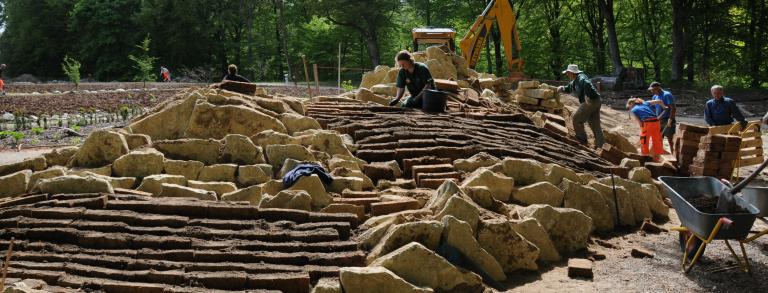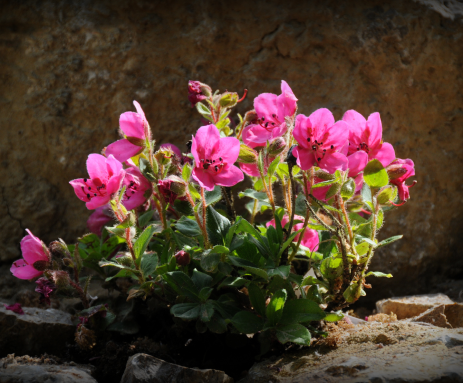ON NOVEMBER FIRST, 2008, Zděnek Zvolánek came from the Czech Republic to give a lecture to the Alpine Garden Society of Denmark on the pervasive phenomenon of the crevice garden. We arrived at the conference, the Gedved State Seminar, with a high degree of expectation, eager to learn more about this type of rock garden.
After Zděnek's immersive lecture, accompanied by very beautiful and descriptive photos, and after a very exciting day in Gedved ended, there was no doubt in our minds that we had to construct a crevice garden at the Bangsbo Botanical Garden, which is located in North Jutland, near the town of Frederikshavn. The area we imagined for it was already laid out as a rock garden, but the question had been in the air for a long time: how do we make it appear as natural as possible?
With Zděnek’s book on crevice gardens in hand, we went home to Frederikshavn. A seed was definitely sown. No matter how inspiring and engaging the lecture had been, we needed to hear the expert’s ideas for the design of such a garden, and we, therefore, decided to ask Zděnek to visit Frederikshavn to see the site and offer some good advice. A talk with the protagonist, however, did not give us hope that there was room in his calendar for such a visit. He is a very busy and sought-after man, and we expected him to be too busy for such a visit years into the future. Fortunately, the phone rang on Sunday, November second and Zděnek promised he would come to Bangsbo in May 2009, and build a “monument to the Old World.” Rarely has a good vintage Amarone been opened so quickly by the chairman of Botanical Garden, Egon Svendsen. Obtaining this appointment was something of a coup.
Planning then started, and the essential challenge was to find the right stone. Correspondence with Zděnek led to a connection with the Botanical Garden in Hof, approximately 60 miles (100 km) from the Czech border. Some limestone from a local quarry was available and was highly recommended by Christoph Ruby, a botanist from Hof. We decided at the end of March 2009 to order 250 tons of flat stone from Marktrodach, near Hof, for delivery so the rock would be ready in Bangsbo when Zděnek and Joyce Carruthers arrived on May 11th. It proved not to be the easiest trade agreement we had ever negotiated. First, there was a problem getting the stones stacked on pallets and then the price went up. Second, there was a problem getting approval from the German authorities for the delivery and then the price went up again. Finally, they could only deliver 25 tons per week. There was some nail-biting as the date of Zděnek`s arrival was quickly approaching, but, finally, the first stone delivery arrived the day Joyce and Zděnek arrived in Frederikshavn by train from the Czech Republic.
Then the work had to be done. All preparatory work had been previously described by Zděnek and completed prior to their arrival. An agreement had been made with the Bangsminde machine station in Frederikshavn to make a gardener and engineer available to work on the project for the two weeks Zděnek had set aside for his trip. This machine station has helped us several times on garden projects, entirely without payment. In addition to providing these competent workers, there were several volunteers to help, many of whom had taken time off from their work to participate in this epoch-making project. Twenty-five tons of stone sounds a lot, but under Zděnek`s knowledgeable leadership, the stone was put in place in only two days. It would be a week before the next stone delivery showed up, so we experimented with putting peat blocks between the stones. Normally the core of the crevices is fine gravel, but according to Zděnek, a core of peat blocks had not been tried before and sphagnum-filled crevice areas would allow us to grow more acid-loving plants.
Zděnek`s working methods puzzled us a little at first. We were inclined to start from one end and work our way methodically to the other end, but Zděnek selected stones and put them together in small islands here and there in groups of five to ten stones. It seemed a bit chaotic at first and it was difficult to maintain the correct east-west orientation of all the stones when it was not possible to look up over the mountain of sand which formed the core of the crevice garden, but Zděnek always managed to tie the islands together. Eventually, everything formed a unit, and it actually helped us in the end, for it gradually became clear to us that Zděnek could not stay and complete the work since the stone deliveries were so slow to arrive. He simply built the strategic points in the crevice garden, which was 164 feet (50 m) in length and 32 feet (10 m) wide, and it was up to us to complete the remainder of the work from those points.
It also became clear that the bed should be divided into continents. We had already dedicated part of the bed to plants from the Himalayas, Alps, Japan, and the Caucasus, and the western part of the crevice was dedicated to North American plants. Small paths in the various beds were designated as borders between continents. As the stones were set in place, Joyce Carruthers jumped around in the beds, planting the little plants we had already acquired, and we have never seen anyone so careful with planting as Joyce. When we had run out of stones before the next shipment came in, Zděnek also went in and strategically planted in the correct places, but often, Joyce would come by the following day, dig up the plant, and replant it “properly.”
Everything has an end, and we understood that Joyce and Zděnek’s last day working in Bangsbo Botanical Garden would be May 26th. The Chairman of the Technical Committee in Frederikshavn, Jens Hedegaard Kristensen, then warmly thanked Joyce and Zděnek for their innovative work creating the crevice garden. Zděnek replied that it was an honor to be part of building the world’s largest crevice garden in part of the Old World.
We put Joyce and Zděnek on the train to Prague the next morning and we all felt we had spent time with and benefited from working with these talented and committed people, who really know their stuff. With their help we knew we would create a wonderful feature for our part of Denmark.
It was now up to us to get the crevice garden done. We still had quite a few plants from New Zealand and had not yet appointed part of the crevice garden to New Zealand alpine flora. The solution was obvious. We simply had to build a new bed for them, next to the big bed, dedicated to New Zealand plants.
We were, and still are in contact with Zděnek by mail, and he approves further additions and alterations to the crevice garden, as well as giving us ideas about what plants he wants to see added and where they should be located in the stones. Since many of the plants we grow are from new collections and have not been available before, we experiment with plants to determine their hardiness and where they will thrive best in the crevices. We have created several places between the stones for some limestone scree areas and will see if the plants thrive in this environment.
We grow an estimated eight to ten thousand plants in our crevice and tufa beds, and we still have many yet to plant. Here in Denmark we get a lot of rain, almost no winter and rarely any snow cover these days, so many plants don’t survive long, but then there is room for some new ones.
Zděnek’s very last whim, before he left, was to propose to create a small tufa area next to the New Zealand section, when the major stone work was almost complete. These tufa stones are perfect for the many saxifrage species and varieties. To create a proper setting for the collection, we had to find some tufa and luckily found a source in Germany near the Czech border. We ordered ten tons, which was delivered to Bangsbo Botanical Garden on August 4th. Then the challenge was to put it together so that it would all look like part of a natural mountain. It was not an easy task, but we thought the results were satisfactory. An order of many saxifrages was placed from various nurseries. When they arrived, they were planted into the tufa, so in March all the tufa stones are covered with saxifrage flowers. During this period, the crevice garden is filled with people admiring and taking photographs of the plants.
Immediately after Zděnek’s and Joyce’s visit, we received the sad news that Joyce had died in an automobile accident in Canada, a very sad message as Joyce was an amazingly happy and exciting person. Karel Lang, one of the most accomplished saxifrage breeders from the Czech Republic, named one of his saxifrages for Joyce and we planted this hybrid in our tufa bed. Every spring when it flowers, our thoughts go out to Joyce.


